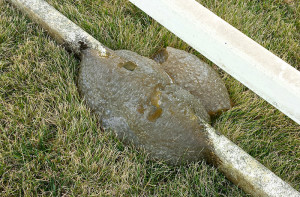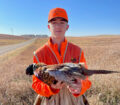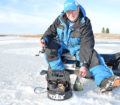By John H. Wills
Clean Water Alliance Coordinator
 If you are swimming and bump into what looks like a brain from Saturn don’t get freaked out because it is just a harmless bryozoan colony. Recently an interesting find has been discovered in the Iowa Great Lakes. Just as last year’s discovery of fresh water sponges, this year an unusual discovery of Bryozoans was found.
If you are swimming and bump into what looks like a brain from Saturn don’t get freaked out because it is just a harmless bryozoan colony. Recently an interesting find has been discovered in the Iowa Great Lakes. Just as last year’s discovery of fresh water sponges, this year an unusual discovery of Bryozoans was found.
Many who have lived and worked in the area for years have not seen these fascinating creatures. Because they are unusual, below is the “description of this weird blobby critter”.
There are 20 kinds of fresh water Bryozoans and they live in colonies, which can get as big as a basketball and a new colony will start from larva which are like seeds. Being water animals, Bryozoans eat and digest tiny animals called plankton by filtering them out of the water. Each bryozoan is about 1/32 of an inch long.
Freshwater bryozoan colonies are usually found around branches that have fallen into still water. If you cut one of these colonies in two you would find gelatinous stuff inside. This gelatinous stuff is often made of calcium carbonate, chitin, or a mixture of both.
Colonies of Bryozoans are started by a single individual, which after its larval existence settles onto something solid in the water and after a little growth begins to reproduce asexually (by budding). Thus a colony is composed entirely of clones (genetically identical individuals) of the first animal, which is called the ancestrula. Colonies can grow quite quickly if the circumstances are right.
A colony of Schizoporella sanguinea was observed to grow from a single ancestrula to a colony of 38,000 individual zooids in just five months. It was 5 inches across by this stage.
The individual animals within a colony are called zooids. Each zooid secretes and lives inside a non-living case called a zooecium (pl. zooecia). These zooecia come in many different shapes and are interconnected in different ways depending on their shape. Species with simple rectangular box-like zooecia form mat like colonies, while other species with vase shaped zooecia build branching tree-like and fan-like colonies up to 1 foot high.
Each zooecium has a hole at the top called an orifice through which the animal can extend its ring of tentacles or lophophore when it is feeding. In some species this orifice can be sealed shut by a sort of door called an operculum.
The living animals can extend, and particularly retract, their lophophore as circumstances require, a bit like a ‘Jack-in-the-Box’, often with great speed. This is a defense against predation, and also helps protect the animal against accidental damage and dehydration. The individual zooids are very small; the largest species is only about 5/32 of an inch long.
Although colonies can become quite large, up to 3 feet across, they are more commonly only less than 1 inch across or 1/2 an inch high.
Information above found at: http://cleanwateralliance.us6.list-manage.com/track/click?u=eef0eadb5721c0457067e632b&id=05886a1d72&e=e4933cd7fe

















Also found at Browns Lake and Synder Bend Lake attached to the docks